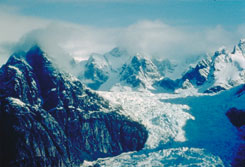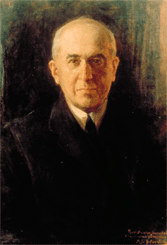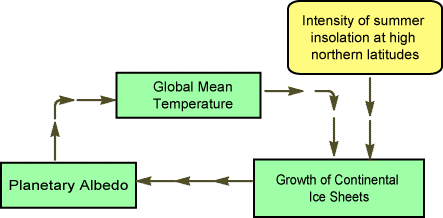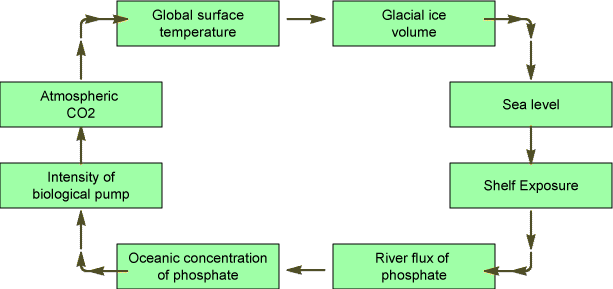 Climate change can
result from the action of any of the processes affecting the
climate system. However, changes that affect the whole earth, or
major portions thereof, for at least several years, are likely to
arise from a relatively small number of causes.
Climate change can
result from the action of any of the processes affecting the
climate system. However, changes that affect the whole earth, or
major portions thereof, for at least several years, are likely to
arise from a relatively small number of causes.
These changes can be split into external, in which the agent of cause is outside the climate system, and internal, where the initial alteration is within the system itself.
Isolating a particular cause for a particular change, however, is extremely difficult because the interlinked nature of the system ensures that there are feedbacks, so that a change in one component leads to a change in most, if not all, other components.
It is not possible to explain with certainty the climatic changes of the Pleistocene. To explain repeated advance and retreat of ice sheets, there needs to be some mechanism to change the amount of energy received at high latitudes.
 |
| In the 1910s, the Serbian mathematician Milutin Milankovitch, began to embark on a series of calculations that would eventually revive the orbital theory of climate change. |
The Milankovitch cycles explain only about 1/2° out of a mean difference of 4° in global temperature.
It seems that orbital forcing is a major factor in the timing of glaciations and deglaciations but exactly how it affected climate leading to ice sheet growth and decay is less clear.
These cycles cannot explain the relatively short-period variations (less than 20,000 years) that have been observed or the long period without an ice age that occurred just before the last million years.
The dominant periodicity of glacial-interglacial fluctuations has been 100,000 years; if this phenomena is a result of eccentricity changes, an amplifier is needed. The important climate variables that we need to consider are albedo and the greenhouse effect.
 |
| Feedback diagram showing the effect of changes in glacial growth on global temperature. |
Any change in the seasonal distribution of solar insolation that affects the growth of ice during the winter or the snowmelt during the summer has the potential to affect the planetary albedo.
As ice sheets begin to grow, they convert a region that previously had reduced albedo during the summer, as snow melted, to one that maintains high albedo throughout the year. The annual average albedo thus increases, which will lead to both a regional and a global cooling. This cooling will accelerate the growth of the continental ice and will allow it to spread to low latitudes.
The ice-albedo feedback has the potential to explain the entire amplification of the Milankovitch forcing needed for the observed climate change. However, studies of polar ice cores indicate that carbon dioxide levels have also varied substantially.
The photosynthetic conversion of dissolved carbon dioxide to organic matter in the surface ocean, the settling of this material through the water column, and its decomposition at depth dominates the distribution of carbon throughout the world's ocean. This process is called the biological pump.
The low CO2 concentrations of glacial intervals might be the result of a more efficient biological pump. But, why might the glacial ocean support greater biological productivity?
 |
| Diagram of the shelf nutrient hypothesis of the reduction of atmospheric carbon dioxide during glaciation. |
As the glaciers grew, sea level fell, exposing the vast margins of the continents (the continental shelves). Sediments of these continental shelves are rich in organic matter and nutrients, which become exposed and can be carried to the oceans by rivers.
This nutrient release enhanced the global delivery of phosphate concentrations, marine productivity, and carbon export from the surface ocean, and a drop in atmospheric CO2.
 |
| Iron fertilization hypothesis for the intensification of the biological pump during glaciations. |
Iron plays an important role in limiting the productivity in certain regions of the ocean. These regions might have received additional supplies of iron during glaciations.
The most likely source of iron was windblown dust particles, produced by regions that became more arid during glaciation. Winds might have intensified in response to a greater equator-to-pole temperature gradient.
 |
| Diagram of the coral reef hypothesis. |
The continental shelves between 30°N and 30°S latitude provide a habitat that is ideal for the growth of corals. As these organisms grow, carbon dioxide is needed, and thus depleted from the atmosphere.